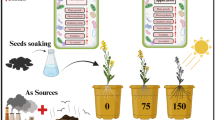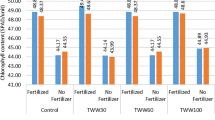Abstract
To improve the nutritional and commercial value of grape, and to meet the human body's requirement for selenium (Se), it is important to increase the absorption capacity of grapevine for Se. In this study, different straws of Solanum sect. Solanum (Solanaceae) plants (Solanum nigrum var. humile (Bernh. ex Willd.) C.Y. Wu & S.C. Huang, Solanum diphyllum L., Solanum nigrum L., and Solanum alatum Moench) were mixed into the Se-supplemented soil before planting the ‘Summer Black’ grape seedlings. Then, the physiological and Se accumulation characteristics of grapevine were studied after planting for two months in the pre-treated soil. The obtained results showed that the photosynthetic pigments (chlorophyll a, chlorophyll b and carotenoid) content, the antioxidant enzymes (superoxide dismutase, peroxidase and catalase) activity, and the biomass of grapevine were increased by S. nigrum var. humile, S. diphyllum and S. nigrum straw amendments, while S. alatum straw amendment led to opposite results. Furthermore, grapevine Se concentration, soil pH and available soil Se concentration were also significantly improved by mixing with the straws of S. nigrum var. humile, S. diphyllum, and S. nigrum and the significant positive correlations between them were observed. In conclusion, S. nigrum var. humile, S. diphyllum, and S. nigrum straw amendments were beneficial for the growth and accumulation of Se in grapevine. In terms of Se concentration in the grapevine, the S. nigrum straw amendment had the best promoting effect.





Similar content being viewed by others
References
Bañuelos GS, Arroyo I, Pickering IJ, Yang SI, Freeman JL (2015) Selenium biofortification of broccoli and carrots grown in soil amended with Se-enriched hyperaccumulator Stanleya pinnata. Food Chem 166:603–608
Borrill P, Connorton JM, Balk J, Miller AJ, Sanders D, Uauy C (2014) Biofortification of wheat grain with iron and zinc: integrating novel genomic resources and knowledge from model crops. Front Plant Sci 5:53–60
Dinh QT, Cui Z, Huang J, Tran TAT, Wang D, Yang W, Zhou F, Wang M, Yu D, Liang D (2018) Selenium distribution in the Chinese environment and its relationship with human health: a review. Environ Int 112:294–309
Dinh QT, Wang M, Tran TAT, Zhou F, Wang D, Zhai H, Peng Q, Xue M, Du Z, Bañuelos GS, Lin ZQ, Liang D (2019) Bioavailability of selenium in soil-plant system and a regulatory approach. Crit Rev Environ Sci Technol 49(6):443–517
Feng T, Chen SS, Gao DQ, Liu GQ, Bai HX, Li A, Peng LX, Ren ZY (2015) Selenium improves photosynthesis and protects photosystem II in pear (Pyrus bretschneideri), grape (Vitis vinifera), and peach (Prunus persica). Photosynthetica 53:609–612
Fernandes KFM, Berton RS, Coscione AR (2014) Selenium biofortification of rice and radish: effect of soil texture and efficiency of two extractants. Plant Soil Environ 60(3):105–110
Gupta M, Gupta S (2017) An overview of selenium uptake, metabolism, and toxicity in plants. Front Plant Sci 11:2074–2087
Hartikainen H (2005) Biogeochemistry of selenium and its impact on food chain quality and human health. J Trace Elem Med Biol 18(4):309–318
Hatamian M, Nejad AR, Kafi M, Souri MK, Shahbazi K (2020) Nitrate improves hackberry seedling growth under cadmium application. Heliyon 6(1):e03247
Heijboer A, Berge HFMT, Ruiter PCD, Jørgensen HB, Kowalchuk GA, Bloem J (2016) Plant biomass, soil microbial community structure and nitrogen cycling under different organic amendment regimes; a 15N tracer-based approach. Appl Soil Ecol 107:251–260
Huang W, Bai Z, Hoefel D, Hu Q, Lv X, Zhuang G, Xu S, Qi H, Zhang H (2012) Effects of cotton straw amendment on soil fertility and microbial communities. Front Environ Sci Eng 6(3):336–349
Huang K, Gao X, Xiao L, Shu J, Li Q, Liao M (2019) Effects of Solanum nigrum, Crassocephalum crepidioides and Bidens pilosa straws on the nutrients content of soil and grape seedlings under cadmium stress. E3S Web of Conf 136:07011–07014
Huang K, Han J, Huang Y, Jing Q, Li A, Liao M (2020) Comparison of selenium accumulation in three Solanum species. IOP Conf Ser Earth Environ Sci 446:032009–032012
Jin ZX, Sun TY, Sun H, Yue QY, Yao YX (2016) Modifications of ‘Summer Black’ grape berry quality as affected by the different rootstocks. Sci Hortic 210:130–137
Karimi R, Ghabooli M, Rahimi J, Amerian M (2020) Effects of foliar selenium application on some physiological and phytochemical parameters of Vitis vinifera L. cv. Sultana under salt stress. J Plant Nutr 43(14):2226–2242
Kieliszek M, Błażejak S (2013) Selenium: significance and outlook for supplementation. Nutrition 29(5):713–718
Lehotai N, Lyubenova L, Schröder P, Feigl G, Ördög A, Szilágyi K, Erdei L, Kolbert Z (2016) Nitro-oxidative stress contributes to selenite toxicity in pea (Pisum sativum L). Plant Soil 400:107–122
Li HS (2000) Principles and techniques of plant physiological biochemical experiment. Higher Education Press, Beijing
Li H, Dai M, Dai S, Dong X (2018) Current status and environment impact of direct straw return in China’s cropland—a review. Ecotoxicol Environ Saf 159:293–300
Li Z, Fan R, Peng X, Shu J, Liu L, Wang J, Lin L (2022) Salicylic acid alleviates selenium stress and promotes selenium uptake of grapevine. Physiol Mol Biol Plants 28:625–635
Lin L, Li Z, Wang J, Liang D, Xia H, Lv X, Tang Y, Wang X, Deng Q, Liao M (2023) 24-epibrassinolide promotes selenium uptake in grapevine under selenium stress. Sci Hortic 308:111564
Liu L, Wang T, Sui L, Liu J, Lin L, Liao M (2019) The selenium accumulation characteristics of grape seedlings. IOP Conf Ser Earth Environ Sci 330:042042
Liu P, Huang KW, Dai JT, Li R, Wang JY, Cheng Q, Wang YX, Liao MA, Lin LJ (2021) Effects of applying Pterocypsela laciniata straw on growth and selenium accumulation of grape seedlings. J Hum Agric Univ (Natl Sci) 47(1):35–39
Manaf HH (2016) Beneficial effects of exogenous selenium, glycine betaine and seaweed extract on salt stressed cowpea plant. Ann Agric Sci 61(1):41–48
Mellem JJ, Baijnath H, Odhav B (2012) Bioaccumulation of Cr, Hg, As, Pb, Cu and Ni with the ability for hyperaccumulation by Amaranthus dubius. Afr J Agric Res 7(4):591–596
Mostofa MG, Hossain MA, Siddiqui MN, Fujita M, Tran LSP (2017) Phenotypical, physiological and biochemical analyses provide insight into selenium-induced phytotoxicity in rice plants. Chemosphere 178:212–223
Padmaja K, Somasekharaiah B, Prasad A (1995) Inhibition of chlorophyll synthesis by selenium: involvement of lipoxygenase mediated lipid peroxidation and antioxidant enzymes. Photosynthetica 31:1–7
Pérez-sirvent C, Martínez-sánchez MJ, García-lorenzo ML, Molina J, Tudela ML, Mantilla W, Bech J (2010) Selenium content in soils from Murcia Region (SE, Spain). J Geochem Explor 107(2):100–109
Pilon-smits EAH, Leduc DL (2009) Phytoremediation of selenium using transgenic plants. Curr Opin Biotechnol 20(2):207–212
Puccinelli M, Malorgio F, Pezzarossa B (2017) Selenium enrichment of horticultural crops. Molecules 22(6):933–950
Silva VM, Boleta EHM, Lanza MGDB, Lavres J, Martins JT, Santos EF, Santos FLMD, Putti FF, Junior EF, White PJ, Broadley MR, Carvalho HWPD, Reis ARD (2018) Physiological, biochemical, and ultrastructural characterization of selenium toxicity in cowpea plants. Environ Exp Bot 150(6):172–182
Souri MK, Hatamian M (2017) Aminochelates in plant nutrition: a review. J Plant Nutr 42(1):67–78
Souri MK, Alipanahi N, Hatamian M, Ahmadi M, Tesfamariam T (2018) Elemental profile of heavy metals in garden cress, coriander, lettuce and spinach, commonly cultivated in Kahrizak, south of Tehran-Iran. Open Agric 3(1):32–37
Souri MK, Hatamian M, Tesfamariam T (2019) Plant growth stage influences heavy metal accumulation in leafy vegetables of garden cress and sweet basil. Chem Biol Technol Agric 6:25–31
Sun RL, Zhou QX, Jin CX (2006) Cadmium accumulation in relation to organic acids in leaves of Solanum nigrum L. as a newly found cadmium hyperaccumulator. Plant Soil 285:125–134
Sun X, Wang Y, Han G, Ye S, Zhou X (2020) Effects of different selenium forms on selenium accumulation, plant growth, and physiological parameters of wild peach. S Afr J Bot 131:437–442
Vinceti M, Filippini T, Wise LA (2018) Environmental selenium and human health: an update. Curr Environ Health Rep 5:464–485
Wang D, Xue MY, Wang YK, Zhou DZ, Tang L, Cao SY, Wei YH, Yang C, Liang DL (2019) Effects of straw amendment on selenium aging in soils: mechanism and influential factors. Sci Total Environ 657:871–881
Wang Y, Wang X, Deng Q, Mao M, Xia H, Wang J, Lv X, Wang Y, Zhang H, Zhang X, Luo X (2021) Living plants and straws of four hyperaccumulator plants increase the cadmium uptake of Ziziphus acidojujuba seedlings. Int J Environ Anal Chem. https://doi.org/10.1080/03067319.2021.1882450
Wei T, Zhang P, Wang K, Ding R, Yang B, Nie J, Jia Z, Han Q (2015) Effects of wheat straw incorporation on the availability of soil nutrients and enzyme activities in semiarid areas. PLoS One 10(4):e0120994–e0121008
Zhang Y, Frankenberger WT (2003) Factors affecting removal of selenate in agricultural drainage water utilizing rice straw. Sci Total Environ 305(1–3):207–216
Zhang L, Shi W, Wang X (2006) Difference in selenite absorption between high- and low- selenium rice cultivars and its mechanism. Plant Soil 282:183–193
Zhang S, Wang Y, Shen Q (2018) Influence of straw amendment on soil physicochemical properties and crop yield on a consecutive mollisol slope in northeastern China. Water 10(5):559–574
Funding
This work was financially supported by the Sichuan Provincial Science and Technology Program (2022YFN0005, 2020JDPT0004), Sichuan Fruit Innovation Team (sccxtd-04) and Chengdu Agricultural Science and Technology Talent Cultivation Project (2023–2025).
Author information
Authors and Affiliations
Corresponding authors
Additional information
Communicated by L. Bavaresco.
Publisher's Note
Springer Nature remains neutral with regard to jurisdictional claims in published maps and institutional affiliations.
Rights and permissions
Springer Nature or its licensor (e.g. a society or other partner) holds exclusive rights to this article under a publishing agreement with the author(s) or other rightsholder(s); author self-archiving of the accepted manuscript version of this article is solely governed by the terms of such publishing agreement and applicable law.
About this article
Cite this article
Huang, K., Chen, X., Zhang, R. et al. Effects of different Solanum sect. Solanum (Solanaceae) straw amendments on selenium accumulation and growth of grapevine. Acta Physiol Plant 45, 144 (2023). https://doi.org/10.1007/s11738-023-03627-3
Received:
Revised:
Accepted:
Published:
DOI: https://doi.org/10.1007/s11738-023-03627-3




